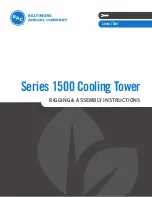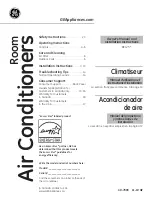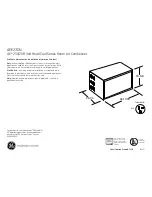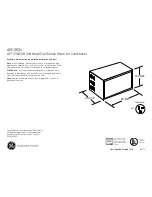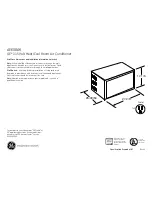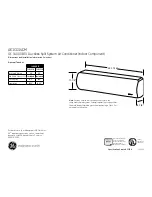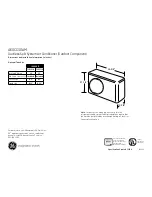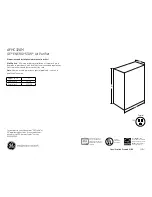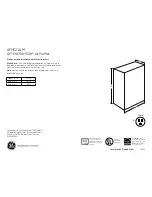
18
Table 3—
Heating Inputs
HEATING INPUT
(BTUH)
NUMBER OF
GAS SUPPLY PRESSURE (IN. WC)
MANIFOLD PRESSURE (IN WC)
NUMBER OF
ORIFICES
Natural
{
Propane*
{
MANIFOLD PRESSURE (IN. WC)
ORIFICES
Min
Max
Min
Max
Natural
{
Propane*†
40,000
2
4.0
13.0
4.0
13.0
3.5
3.5
60,000
2
4.0
13.0
4.0
13.0
3.5
3.5
90,000
3
4.0
13.0
4.0
13.0
3.5
3.4
115,000
3
4.0
13.0
4.0
13.0
3.5
3.7
130,000
3
4.0
13.0
4.0
13.0
3.5
3.5
*When a unit is converted to propane, different size orifices must be used. See separate, natural--to--propane conversion kit instructions.
{
Based on altitudes from sea level to 2000 ft above sea level. For altitudes above 2000 ft, reduce input rating 4 percent for each additional 1000 ft above sea level. In Canada,
from 2000 ft above sea level to 4500 ft above sea level, derate the unit 10 percent.
HEATING SEQUENCE OF OPERATION
(See Fig. 15--17 and unit wiring label.)
On a call for heating, terminal W of the thermostat is energized,
starting the induced--draft motor. When the hall--effect sensor on the
induced--draft motor senses that it has reached the required speed,
the burner sequence begins. This function is performed by the
integrated gas control (IGC). The indoor (evaporator)--fan motor is
energized 45 sec after flame is established. When the thermostat is
satisfied and W is de--energized, the burners stop firing and the
indoor (evaporator) fan motor shuts off after a 45--sec time--off
delay.
LIMIT SWITCHES
Normally closed limit switch (LS) completes the control circuit.
Should the leaving--air temperature rise above the maximum
allowable temperature, the limit switch opens and the control circuit
“breaks.” Any interruption in the control circuit instantly closes the
gas valve and stops gas flow to the burners and pilot. The blower
motor continues to run until LS resets.
When the air temperature at the limit switch drops to the
low--temperature setting of the limit switch, the switch closes and
completes the control circuit. The direct--spark ignition system
cycles and the unit returns to normal heating operation.
Table 4—
LED Indications
ERROR CODE
LED INDICATION
Normal Operation
On
Hardware Failure
Off
Fan On/Off Delay Modified
1 Flash
Limit Switch Fault
2 Flashes
Flame Sense Fault
3 Flashes
Four Consecutive Limit Switch Faults
4 Flashes
Ignition Lockout Fault
5 Flashes
Induced--Draft Motor Fault
6 Flashes
Rollout Switch Fault
7 Flashes
Internal Control Fault
8 Flashes
Temporary Lock--Out (1 hr)
9 Flashes
NOTES:
1. There is a 3 sec pause between error code displays.
2. If more than one error code exists, all applicable error codes will be displayed in
numerical sequence.
3. This chart is on the wiring diagram located inside the burner access panel.
ROLLOUT SWITCH
The function of the rollout switch is to close the main gas valve in
the event of flame rollout. The switch is located above the main
burners. When the temperature at the rollout switch reaches the
maximum allowable temperature, the control circuit trips, closing
the gas valve and stopping gas flow to the burners. The indoor
(evaporator) fan motor (IFM) and induced draft motor continue to
run until switch is reset. The IGC LED will display FAULT CODE
7.
Step 3—Start--up Cooling and Make Adjustments
Complete the required procedures given in the Pre--Start--Up
section before starting the unit. Do not jumper any safety devices
when operating the unit. Do not operate the compressor when the
outdoor temperature is below 40
°
F (4.4
°
C) (unless accessory
low--ambient kit is installed). Do not rapid--cycle the compressor.
Allow 5 minutes between on cycles to prevent compressor damage.
CHECKING COOLING CONTROL OPERATION
Start and check the unit for proper cooling control operation as
follows:
1. Place room thermostat SYSTEM switch in OFF position.
Observe that blower motor starts when FAN switch is placed
in ON position and shuts down when FAN switch is placed
in AUTO position.
2. Place SYSTEM switch in COOL position and FAN switch
in AUTO position. Set cooling control below room
temperature. Observe that compressor, condenser fan, and
evaporator blower motors start. Observe that cooling cycle
shuts down when control setting is satisfied. The evaporator
fan will continue to run for 30 sec.
3. When using an auto--changeover room thermostat, place
both SYSTEM and FAN switches in AUTO positions.
Observe that unit operates in Heating mode when
temperature control is set to call for heating (above room
temperature) and operates in Cooling mode when
temperature control is set to call for cooling (below room
temperature).
IMPORTANT
: Three--phase, scroll compressors are direction
oriented. Unit must be checked to ensure proper compressor
3--phase power lead orientation. If not corrected within 5 minutes,
the internal protector will shut off the compressor. The 3--phase
power leads to the unit must be reversed to correct rotation. When
turning backwards, the difference between compressor suction and
discharge pressures will be minimal.
CHECKING AND ADJUSTING REFRIGERANT CHARGE
The refrigerant system is fully charged with Puron
R
(R--410A)
refrigerant and is tested and factory sealed. Allow system to operate
a minimum of 15 minutes before checking or adjusting charge.
NOTE
:Adjustment of the refrigerant charge is not required unless
the unit is suspected of not having the proper Puron
R
(R--410A)
charge.
The charging label and the tables shown refer to system
temperatures and pressures in cooling mode only. A refrigerant
charging label is attached to the outside of the service access door.
The chart includes the required liquid line temperature at given
discharge line pressures and outdoor ambient temperatures.
An accurate subcooling, thermocouple-- or thermistor--type
thermometer, and a gauge manifold are required when using the
subcooling charging method for evaluating the unit charge. Do not
use mercury or small dial--type thermometers because they are not
adequate for this type of measurement.
48E
S




























